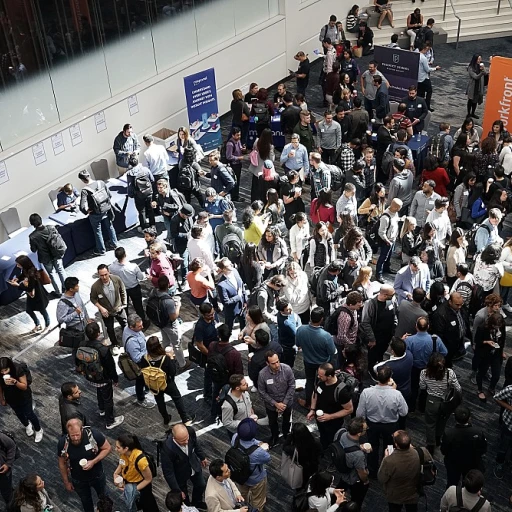
Understanding Applicant Tracking Systems (ATS)
Decoding the Mechanism of ATS
Understanding the intricacies of Applicant Tracking Systems (ATS) is crucial for employers aiming to refine their recruitment process. These advanced systems, often deployed by companies in Denver and beyond, have transformed how organizations manage the entire hiring process. By organizing and tracking the influx of applications, ATS leads to a more streamlined acquisition of top talent.The strategic planning behind ATS usage is evident in their capability to store and analyze vast amounts of candidate data. This aids firms, including those in competitive job markets, in efficiently staffing roles. Not only do these systems assist in shortlisting potential candidates, but they also facilitate employers in ensuring that the candidate experience remains unaffected despite a high volume of applications.
Benefits for Employers and Job Seekers
Employers in Denver find ATS to be a pivotal tool, especially in an era where remote work has become the norm. By automating several aspects of the recruitment process, these systems allow human resources to focus on evaluating more than just skills—it integrates a process of developing trust and transparency. Thus, ATS presents a paper-free, efficient method to refine talent acquisition strategies.For job seekers, having an understanding of how ATS systems function can increase their chances of being noticed by prospective employers. As recruitment becomes more data-driven, job seekers are encouraged to tailor their applications so they align with standardized tracking systems. This alignment ensures their resumes are not lost in the pool of candidates but are apt for human review in pursuit of new opportunities in the Denver job market.
All these aspects underline the importance of establishing a symbiotic connection between human interfaces and automated systems. For more insights on developing trust and transparency in your team, check out this article on modern leadership.
The Rise of ATS in Denver's Job Market
Denver's Job Market Embraces ATS
The job market in Denver has seen a significant shift towards the adoption of Applicant Tracking Systems (ATS) in recent years. As companies strive to streamline their recruitment process, ATS has become a crucial tool for employers in Denver. This trend is driven by the need to efficiently manage the influx of applications and to identify top talent swiftly.
Employers in Denver are increasingly relying on ATS to enhance their hiring process. These systems allow companies to automate the initial stages of recruitment, reducing the time spent on manual sorting and enabling a more strategic approach to talent acquisition. By leveraging ATS, employers can focus on engaging with candidates who are the best fit for their roles.
Enhancing Candidate Experience
One of the key benefits of using ATS in Denver's job market is the improvement in candidate experience. With the ability to track applications seamlessly, candidates receive timely updates on their application status, which enhances their overall experience. This transparency is crucial in maintaining a positive relationship with potential hires, even if they are not selected for the position.
Moreover, ATS systems facilitate a paper-free recruitment process, which aligns with the growing trend of remote work and digital transformation. This shift not only benefits employers by reducing administrative burdens but also appeals to job seekers who value efficiency and modernity in the hiring process.
Strategic Planning and Data-Driven Decisions
ATS provides employers with valuable data that can inform strategic planning and decision-making. By analyzing recruitment data, companies can identify patterns and trends that influence their hiring strategies. This data-driven approach allows employers to refine their recruitment process, ensuring they attract and retain top talent in a competitive job market.
For companies in Denver, integrating ATS into their recruitment strategy is not just about keeping up with technological advancements; it's about empowering your team and enhancing workforce enablement. By adopting these systems, employers can create a more efficient, candidate-friendly recruitment process that supports long-term employee retention. For more insights on how to empower your team, visit this resource.
Impact of ATS on Employee Retention
Influence on Workforce Loyalty and Stability
The integration of applicant tracking systems (ATS) into the recruitment landscape of Denver's job market has introduced a transformative shift in how companies interact with potential employees. While primarily designed to streamline the recruitment process, ATS has far-reaching implications on employee retention, directly impacting how employers in Denver secure top talent and maintain staffing effectiveness. One of the key benefits of using ATS is the enhancement of the candidate experience. A smoother recruitment process can lead to higher satisfaction among job seekers, reducing the likelihood of candidates abandoning the application midway. Companies that utilize ATS efficiently can offer a paper-free, straightforward experience, ensuring that the process is intuitive and less cumbersome for applicants. This seamless interaction can foster a positive perception of the company, encouraging candidates to be more committed once hired. Moreover, ATS allows employers to gather and analyze data strategically during the hiring process. By leveraging these insights, employers can make more informed decisions about candidate selection, aligning workforce capabilities with company goals. This level of strategic planning not only aids in the immediate recruitment but also helps in nurturing a workforce that feels valued and aligned with long-term organizational objectives. However, challenges remain. The reliance on ATS systems may sometimes lead to overstandardization, potentially overlooking unique candidate qualities that don't fit conventional molds. This can inadvertently affect the workplace dynamic, as diverse talents may not always be adequately represented. Employers must balance automation with personalized human resource practices to safeguard against any negative impact on employee loyalty. Furthermore, in an era where remote work is prevalent, ATS platforms can be employed to facilitate effective management and communication between distributed teams. By integrating robust tracking technologies, companies can better adapt to the evolving nature of work, ensuring that employees—remote or onsite—are engaged and supported. For employers in Denver seeking to harness the full potential of ATS while bolstering retention, a holistic approach that embraces both technology and human-centric engagement is essential. This could involve recognizing and addressing micromanagement tendencies that may arise from data-driven practices, as discussed in this insightful post on workplace dynamics and retention. By aligning technological advancements with a genuine focus on employee well-being, businesses can achieve a harmonious balance, paving the way toward sustainable growth and a loyal workforce.Challenges Faced by Employers Using ATS
Obstacles in Implementing Applicant Tracking Systems
While the integration of applicant tracking systems (ATS) can streamline the recruitment process and potentially enhance employee retention, employers in Denver face several challenges. One major hurdle is the complexity involved in customizing these systems to align with the unique needs of a company's recruitment and hiring process.- Data Management: Employers need to manage vast amounts of data effectively. ATS systems can collect extensive information on candidates, but without coherent data management practices, this data can become overwhelming.
- Candidate Experience: Maintaining a positive candidate experience is crucial. However, automated processes in ATS can inadvertently lead to impersonality, alienating top talent and impacting a company’s appeal in a competitive job market.
- Integration Issues: Many companies struggle with integrating ATS with existing human resources and staffing systems, leading to inefficiencies and potentially slowing down the recruitment process.
Best Practices for Leveraging ATS Effectively
Optimizing ATS Utilization for Enhanced Recruitment
Effectively leveraging applicant tracking systems (ATS) in the recruitment process is crucial for employers in Denver aiming to attract top talent. When implemented correctly, ATS systems can streamline the hiring process, ensuring a more strategic approach to talent acquisition. Here are some best practices for optimizing ATS usage:
- Ensure Compatibility and Integration: Choose ATS solutions that seamlessly integrate with existing human resources platforms. This facilitates a smoother recruitment process and enhances data tracking across departments.
- Tailor the System to Your Needs: Customize the ATS settings to match the specific requirements of your company's recruitment strategy. This will help in targeting the right candidates and improving the overall candidate experience.
- Utilize Data Analytics: Leverage the data provided by ATS to gain insights into market trends and candidate behaviors. Understanding these patterns can help refine search criteria and identify potential improvements in your hiring process.
- Prioritize Candidate Engagement: Ensure communication with candidates is timely and professional. An ATS can automate notifications, ensuring candidates are kept informed throughout the recruitment process, thereby improving their experience.
Employers in Denver should be mindful of these practices to fully realize the potential of ATS solutions, enabling a more effective capture of the ever-evolving job market and reducing the need for extensive manual staffing initiatives. By refining how these systems are utilized, companies can navigate challenges and improve their recruitment outcomes significantly.
Future Trends in ATS and Employee Retention
Emerging Trends in ATS and Their Influence on Retention
As the job market in Denver continues to evolve, so too does the technology that supports it. Applicant Tracking Systems (ATS) are at the forefront of this evolution, with new trends shaping how companies approach recruitment and retention. Here are some key trends to watch:
- Integration with AI and Machine Learning: ATS systems are increasingly leveraging AI to enhance the recruitment process. This integration allows for more efficient candidate screening and matching, ensuring that top talent is identified quickly. By streamlining the hiring process, companies can improve the candidate experience, which is crucial for retaining talent.
- Focus on Candidate Experience: As discussed earlier, the candidate experience is becoming a central focus for employers in Denver. ATS systems are now incorporating features that enhance communication and engagement with candidates, making the recruitment process more transparent and enjoyable. This focus not only attracts top talent but also contributes to higher retention rates.
- Remote Work Adaptations: With the rise of remote work, ATS systems are adapting to support virtual recruitment processes. This includes video interview capabilities and digital onboarding solutions, which are essential for hiring and retaining remote employees effectively.
- Data-Driven Decision Making: The ability to analyze recruitment data is becoming a significant advantage for employers. ATS systems provide valuable insights into the hiring process, allowing companies to make informed decisions about their talent acquisition strategies. This data-driven approach helps in identifying potential retention issues early and addressing them proactively.
- Paper-Free Processes: The shift towards digital solutions is making the recruitment process more efficient and environmentally friendly. By reducing reliance on paper, companies can streamline their operations and focus on strategic planning for talent acquisition and retention.
These trends highlight the ongoing transformation of ATS systems and their role in shaping the future of recruitment and employee retention in Denver. As companies continue to adapt to these changes, they will be better positioned to attract and retain top talent in a competitive job market.












